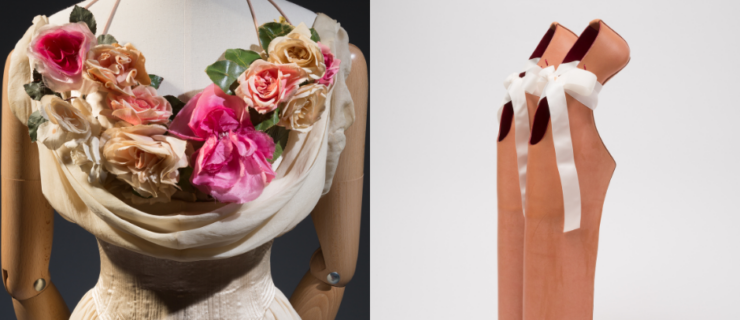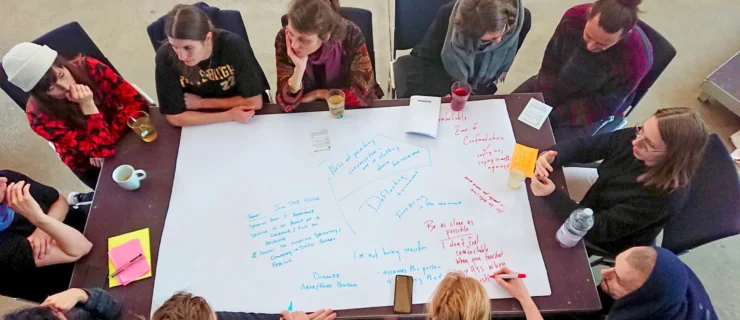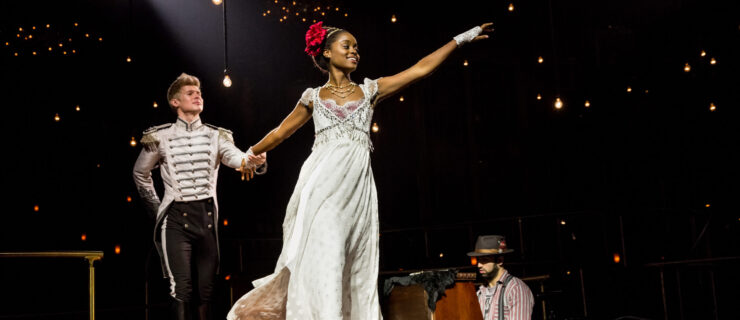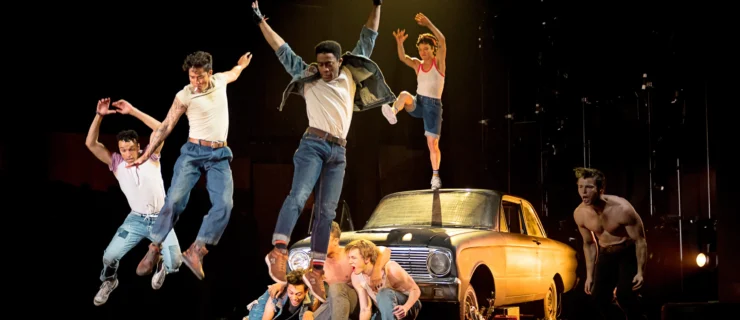Reviews
Martha Graham Dance Company
Rose Theater at Lincoln Center, NYC • March 16–19, 2011 • Reviewed by Wendy Perron
Lacking its recent star, Fang-Yi Sheu (who has returned to her home country of Taiwan), the Graham company rose to the occasion of its 85th anniversary. Blakeley White-McGuire emerged as a major Graham interpreter, Katherine Crockett was a towering presence, and Tadej Brdnik portrayed strong characters. A new dancer from China, Xiaochuan Xie, was a ray of sunshine.
The revival of Snow on the Mesa (1995) by avant-garde theater director Robert Wilson riveted the eye. Intended as a homage to Graham, the lights (abrupt changes of highly saturated colors), sounds (at times sudden thunder), and props (three wolf heads scattered on the floor) were drastic. A severe Noguchi-like chair slid offstage seemingly on its own. (This season celebrated Graham’s long collaboration with the Japanese sculptor Isamu Noguchi.) At least once, the dancers walked with the Primitive Mysteries stride-halt rhythm, but backward. Spliced into the slow movement were split-second flurries of fury and you’d think, Did that just happen? The women looked topless in Donna Karan’s transparent leotard tops with full black skirts. At the end, all 13 dancers wore long white cloths from chin to floor, as though the inner Graham in each had become a sage. Wilson’s glacial pacing is not ideal for a shared program, but he knew how to make the dancers look stunning.
Deaths and Entrances
(1943) is terribly fraught with very little to go on, plotwise. Only once, during a section where the central woman (Miki Orihara) is pulled between the two suitors, do relationships trump sheer posturing. But Orihara seems more upset by her two sisters walking off in a huff. When she comes eyeball to eyeball with a wine glass just as a sinister rumble erupts (music by Hunter Johnson), you have no idea why this goblet nearly caused an earthquake. Edwin Denby wrote in 1944 that Graham’s own magnetic presence held the ballet together, and here is where one missed the fire of Fang-Yi Sheu. Deaths and Entrances is one of Graham’s weaker works.
Therefore, it was quite a challenge to create a “companion piece” to Deaths, which was the assignment given to Taiwanese choreographer Bulareyaung Pagarlava. His world premiere, Chasing, started out silly, with dancers actually chasing each other as though spotting the new Justin Bieber. But its slow, bleak section (sounds of the wind, people blowing this way and that) gained depth when the focus changed from outward to inward. Brdnik turned in a star performance as a lost soul. From the moment he covered his ears and slowly backed up, he was in a different zone. As he wandered about, a woman he embraced slipped away, leaving him sadly holding the air. Another haunted character, White-McGuire, in a pink gown à la Bausch, drifted to the floor in repeated falls, slightly daft. If this piece could be reworked and pried away from Deaths, it might have a future.
In terms of classic Graham, Cave of the Heart (1946) still exerts a spell. In a previous decade, Christine Dakin, with her wholly disturbing jealous convulsions, had been unforgettable as Medea. But White-McGuire was also powerful: A proud woman with the virus of jealousy shuddering deep within her, she was determined to avenge. Xie made a sweet, devoted young lover to Jason, played as an imperious, oblivious hunk by Ben Schultz. Graham was pretty brazen in how she made Jason flaunt his new significant other to Medea. Each character, when not the center of the action, became part of Noguchi’s tableau of stone sculptures, offsetting the intensity of emotion as this Greek drama played out. This formality is partly what dates the ballet. But White-McGuire carried the day, making you believe that good women can do wicked things.
Merce Cunningham Dance Company
Joyce Theater, NYC
March 22–27, 2011
Reviewed by Siobhan Burke
As the Cunningham company approaches its final performance on December 31, should we be getting more nostalgic? Six months from now, the group whose founder radically changed the course of dance history—dispensing with narrative, with that direction called “front,” with the notion of dancing to music—will no longer exist. And the nearer its closure draws, the more hallowed the company becomes: We only have so much time left together. Isn’t this cause for the kind of somber reflection that we undertake in times of mourning?
Well, no. The company’s recent program at the Joyce resisted any such sorrow or wallowing in the past. The three works, spanning four decades—Antic Meet (1958), Quartet (1982), and especially CRWDSPCR (1993)—looked so brisk, fresh, and alive that they held you captive in the present. If, for a moment, you were sad that you might never see these stunning performers again, you could comfort yourself with the thought that they looked so good precisely because you might never see them again. With the end in sight, they have a good reason to give it their all.
“Dance is an art in space and time,” Cunningham said. “The object of the dancer is to obliterate that.” In CRWDSPCR (1993), the dancers come close. Motion never stops during this dazzling piece for 13 individuals. Yes, individuals—because in spite of the mechanical movement, personalities emerge. Jamie Scott is casual, approachable—you kind of want to be friends with her—as she smiles through even the most awkward balances. And Emma Desjardins displays a calm sophistication in her glacial solo, which warps time—stretching it out, slowing it down—amid the otherwise frenetic activity.
Like human Rubik’s Cubes, bodies explore the many possible arrangements of their parts. No permutation goes unconsidered, or so it seems. (This was one of the first pieces Cunningham made using the computer program LifeForms, now known as DanceForms.) Torsos twist in one direction while legs skitter off in another; hips jut out at surprising angles. Arms rifle off odd positions, evoking the fins of a sea creature or the branches of a cherry blossom tree. At every turn, you see the order in randomness that Cunningham was famous for unveiling. Mark Lancaster’s bright blue backdrop and color-block unitards are central to the overall brilliance, as is John King’s electronic blues ’99 (played live by King and Takehisa Kosugi), a sonic forest of unidentifiable noises: gurgles, blips, drones, a sort of melodious lawn-mowing.
Quartet
(a revival) was darker, moodier, more reminiscent of a humid night than a crisp afternoon. Its relationships seemed more human, less driven by chance. The curtain rose on Robert Swinston—the company’s director of choreography and, at 61, its oldest dancer—facing the audience, his upper body bent sharply to one side. Four others (Desjardins, Scott, John Hinrichs, and Marcie Munnerlyn) arrived, but he remained separate, his solitude intensified by their togetherness. As they whirled through chaînés or intertwined on the ground, he stood utterly still or shifted slowly between poses with animal alertness. Again, Desjardins stood out, extracting a luscious quality from the starkness of the movement.
If the evening had one weak link, it was the revival of Antic Meet, which closed the program. The humor of the Martha Graham send-ups and vaudevillian sketches felt dated, despite the dancers’ best efforts. But Rauschenberg’s absurd costumes (the multi-armed sweater, the chair strapped to Daniel Madoff’s back) consistently delighted, so full of personality they were practically characters in themselves.
The idea behind the two-year legacy tour—to let Merce’s company go out with a bang—is obviously working. And while it will be bittersweet to see the troupe go, their planned farewell does something to quiet those typically nagging questions of preservation. (Is Appalachian Spring getting better with age, or worse? Is The Moor’s Pavane the same as it used to be?) The finish line has been drawn; now we can all just enjoy the rest of the ride.
Top: Xiaochuan Xie and Tadej Brdnik in Robert Wilson’s
Snow on the Mesa. Photo by Sinru Ku, Courtesy MGDC
Bottom: Melissa Toogood, Brandon Collwes, and Robert Swinston in
Quartet. Photo by Yi-Chun Wu, Courtesy MCDC




